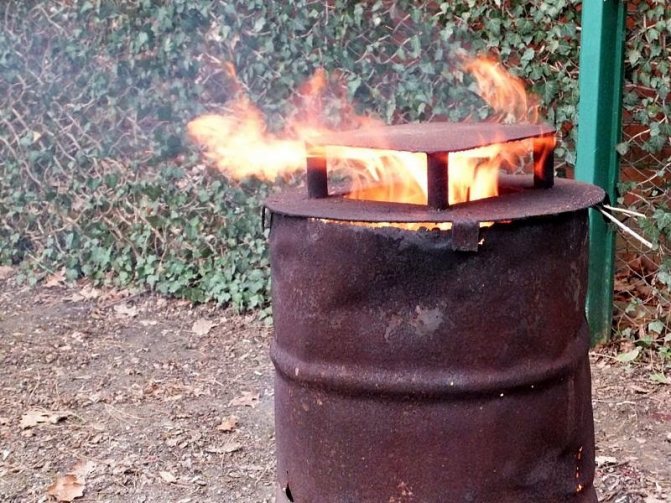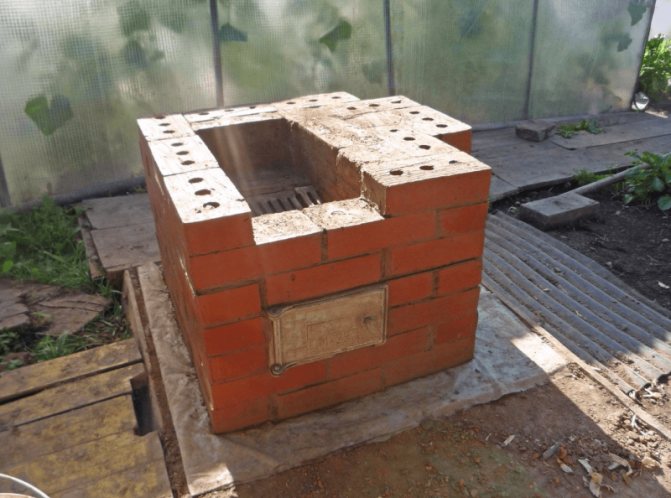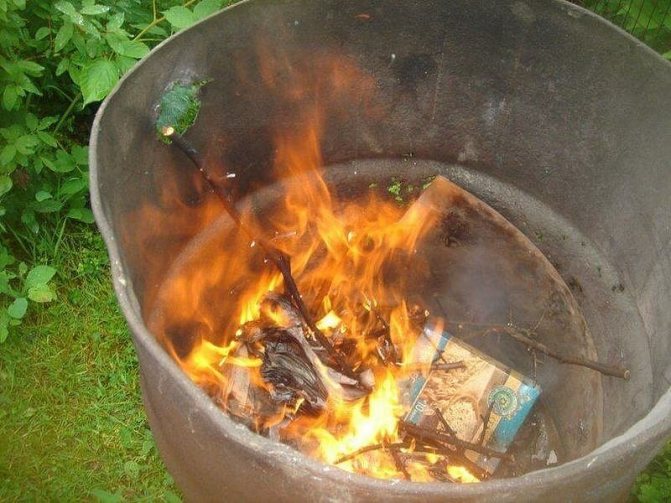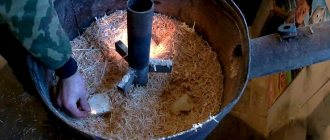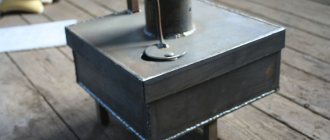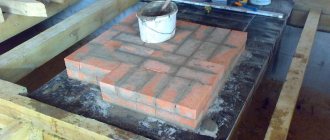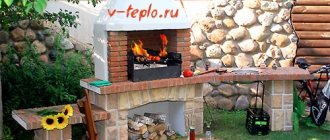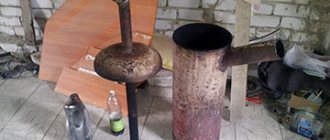21.11.2015
As you know, the main problem of any suburban area is garbage. It is quite expensive to take it out, so summer residents often resort to a more economical option - burning. But lighting fires is an unsafe occupation, it is much better to carry out this "operation" in special containers. They are sold in specialized stores, but if you wish, you can make a garbage oven for your summer cottage with your own hands.
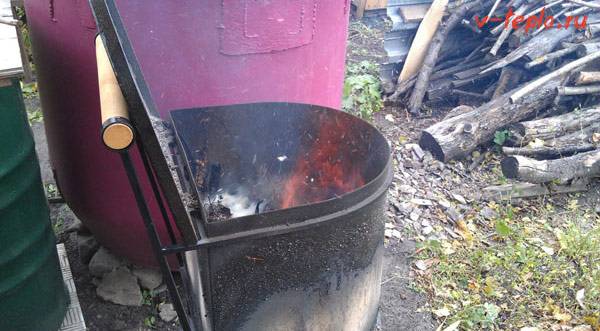
There are several options, let's take a closer look at each of them.
Method one. Upgraded barrel
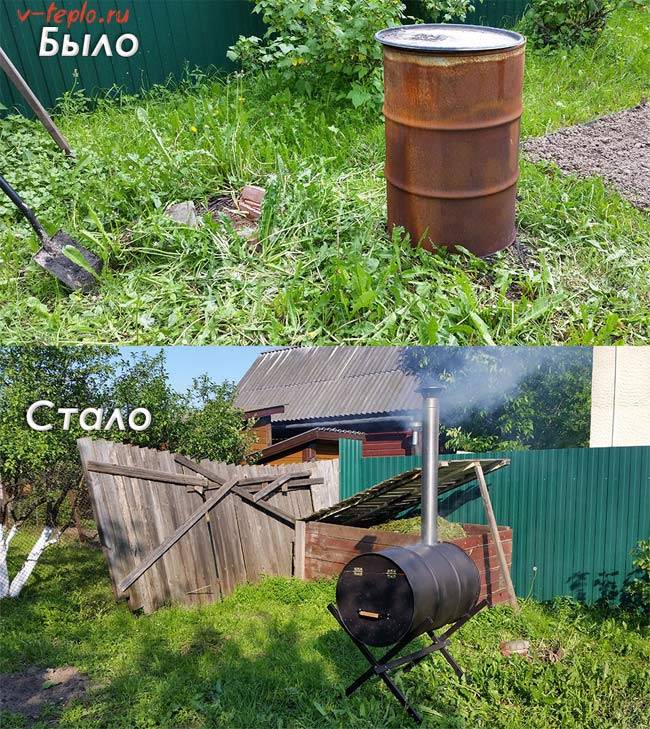

Agree, the options described above using a metal barrel are hardly able to decorate your site. Therefore, you can do it differently.
First, you need a diagram of the future design, we draw it up. It will look something like this.
Preparatory activities
As for the materials, more of them will be required than in any of the methods already known to us. So, in addition to the barrel, you need to prepare:
- 5-meter metal profile (we will cut it into five equal lengths);
- 5 meter steel bar;
- a pair of loops;
- 1 m2 of welded mesh;
- spark arrestor (the diameter of its fasteners should be 11.5 centimeters);
- 200 grams of wire;
- 1.5-meter tin pipe with a diameter of 11.5 centimeters;
- degreaser;
- a handle on which a wooden nozzle is worn;
- bolts - 6 pieces, the same number of nuts;
- electric jigsaw, metal files for it;
- 20 self-tapping screws with wide caps;
- drill for metal with a diameter of 1.2 centimeters;
- grinder, circles to it - emery and for metal;
- the Bulgarian herself;
- refractory paint;
- brushes (as an option - we can use a spray);
- electric drill;
- jigsaw.
Having prepared everything you need, we begin to build a garbage oven for the dacha with our own hands.
The working process
- We cut out the door. To do this, draw a straight line at the bottom to which this door will be attached. We cut along the line with a grinder, while making every effort not to touch the side walls.
- We make a hole in one of the corners of the cut. It is important that it is located close to the side wall of the structure and directly on the cut line. From this point we will move with a jigsaw.
- We insert the jigsaw saw into the hole and carefully cut the bottom of the barrel. At the same time, we do not touch the upper part of it. We move as close as possible to the edges of the barrel. A grinder for this, of course, will not work - only a jigsaw.
- We make several holes in the door through which air will flow. We do them at the bottom, you can in any order.
- If necessary, we clean the barrel of paint or rust using a grinder with an emery disc.
- We build the goats. For this we use five pieces of a metal profile. The trestles will consist of a pair of crosspieces connected by a pull rod. We connect the profile strictly at an angle of 90 degrees, for which we make a pair of holes in each of them and tighten them with bolts.
- We degrease and paint the barrel, do not forget about the elements of the goats. It is advisable to carry out these procedures disassembled. We paint all the elements in several layers, after each layer we wait for the paint to dry completely.
- We collect the goats. We proceed to this a day after painting. Be sure to put washers under the nuts, securely tighten all structural elements. The resulting strength is quite enough for the barrel and the additional weight, which is debris.
- Install hinges and handles. For this we use a screwdriver and self-tapping screws with wide caps.
- We form a hole for the chimney.At the top of the barrel, draw a circle with a diameter of 11.5 centimeters.
- We equip our garbage stove at the dacha with our own hands with a chimney. Install it on the "petals" so that they are inside. After that, in several places we screw the pipe to the “petals” with self-tapping screws so that it does not come off.
- We mount the grate. We do everything as shown in the image below.
- Installing the cover. We fasten it with clamps, although we can resort to such a self-made construction of bolts.
Then we cut this circle with a grinder into a kind of "petals". We should have about ten segments. We bend the "petals" up so that they are positioned vertically.
As a result, we got such a design. That's it, the trash stove is ready, you can start using it!
Do-it-yourself options and manufacturing technologies for incinerators
A waste incinerator can be purchased at a specialty store, but it costs a lot of money. For this reason, home craftsmen have come up with ways to make such a device from scrap materials at home.
From a garden barrel
Every summer cottage has an old barrel. It can be upgraded to create an incinerator.
Necessary materials:
- A metal profile 5 meters long, which is subsequently cut into 5 equal pieces.
- Steel bar - 5 cm.
- Hinges.
- One square meter of welded mesh.
- Wire - 200 g.
- One and a half meter pipe made of tin with a diameter of 11.5 cm.
- Degreaser.
- Handle with wooden attachment.
- 6 bolts and nuts.
- Electric jigsaw.
- 20 self-tapping screws with large caps.
- Drill - 1.2 centimeters.
- Grinder and circles.
- Refractory paint.
- Several brushes or a spray gun.
- Electric drill.
- Electric jigsaw.
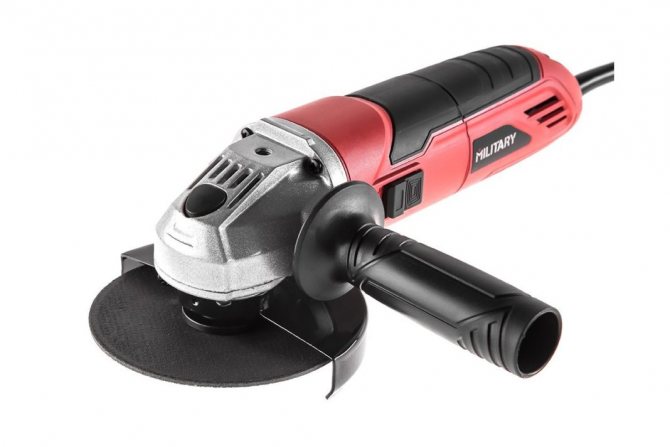

To make an incinerator with your own hands, you need a grinder
Assembly:
- The first step is to cut out the door. Draw a straight line at the bottom of the barrel about 15 centimeters from the edge. Along this line, you should carefully walk the grinder so that the side walls are not damaged.
- A hole is drilled from one end of the cut edge. It should be close to the side wall and on the cut line. It is from this point that you will need to move with a jigsaw.
- The jigsaw file is inserted into the hole and the cutting begins at the bottom of the barrel. The upper part is left untouched, that is, the circle is incomplete.
- Make small holes in the door for air to enter.
- If necessary, the barrel is cleaned of paint and rust.
- Now you can move on to creating a goat. 5 pieces of metal profile are used. As a result, there should be several crosses that are connected by a traction.
- The profile must be connected at an angle of 90 degrees, for this you need to make a hole in the middle, and then fasten the parts with bolts.
- The barrel and the goats are degreased and painted.
- You can start installing the structure a day after the paint has dried.
- Installation of hinges and handles with self-tapping screws and a screwdriver is carried out.
- At the end of the work, you need to make a hole for the chimney. A circle with a diameter of 11.5 cm is drawn in the upper part of the barrel. After the grinder, the drawing is cut into peculiar petals. You should end up with about 10 segments that fold upward into a vertical position. A chimney is attached to this place from a pipe with the required diameter.
- A grate is installed inside the barrel. After that, a cover is attached, fixed with clamps.
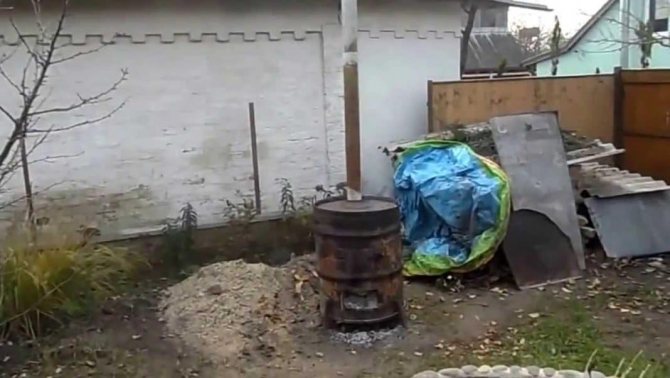

Do-it-yourself waste incinerator from a barrel
The barrel oven is now ready to use.
From an old stove
If there is an unnecessary sauna stove on the site, then it can be adapted for an incineration structure. Even a rusted and rotten version will do.
First, you need to remove all internal elements, and leave only the grate and the body.
Sheet steel is used, welded inwards.Thus, the structure will be stable.
Garbage will be loaded from the top.
For safety during combustion, the unit is covered with a sheet of metal.
Brick
To make an incinerator, you need to use 115 bricks. But the size can be increased at will.
- First, the site is prepared - to clear it of debris and level it. The surface is covered with sand 5 centimeters thick.
- The brick is laid around the perimeter. Do not use cement mortar for this purpose. There should be a small gap of one and a half centimeters between the bricks. Thus, high-quality traction is ensured.
- For the first layer, it is advisable to use 8 bricks: one on the right and on the left, three at the top and bottom.
- Now a metal grid is placed on the created structure. You also need to make an ash pan. There are several options: from brick, pouring from concrete, making from steel - the choice is up to the master.
- For the next row, 8 bricks are also used, but it is necessary to make a binding, therefore, two units are stacked on the sides.
- In the same way, all the following rows are made without cement mortar. The twelfth row must be made solid.
- An iron cover is placed on top.
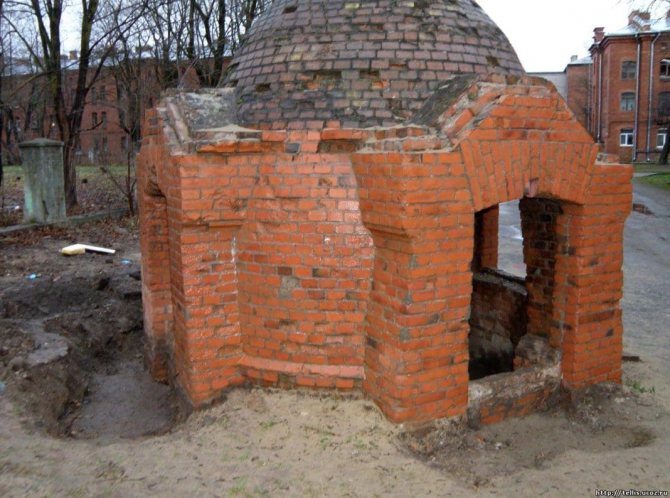

Brick Waste Incinerator
The do-it-yourself brick unit is ready.
Method two. We use a metal barrel
An old waste barrel can be an ideal option for incinerating trash. Having carried out some simple manipulations with it, you will receive a container in which you can safely dispose of all accumulated garbage. Of course, craftsmen have come up with a lot of options for converting a barrel into a stove, but we will consider only a few - the most effective and simple to perform.
"Bottomless" waste disposal barrel
A fairly simple option that does not require much effort or a lot of tools. From the equipment in this case, you only need a hammer, a chisel, an electric drill and a bayonet shovel. The algorithm of actions should be as follows.
Step one. First, we take an old iron barrel and, using a chisel (if possible, this can be done with a grinder), remove its bottom.
Step two. Next, we take a drill and make a couple of holes in the bottom of the barrel. They are necessary in order to provide good traction when burning debris.
Step three. After that, we arm ourselves with a shovel and dig a small oblong hole (its length should be about 100 centimeters, width - 20 centimeters, and the depth should correspond to the height of the shovel bayonet).
Step four. Before starting to incinerate garbage, we kindle a small fire in the pit (we use dry branches and paper for this), and on top we install a barrel without a bottom, but in such a way that the air from the pit freely penetrates into the holes made earlier.
Step five. Garbage can now be placed inside the barrel. We do this gradually, if long branches come across, then it is not at all necessary to saw them - with proper traction, they will soon turn into ash.
Video - Country garbage disposal
There are other ways, let's look at them as well.
Barrel on bricks
This do-it-yourself garbage oven at the dacha is done as follows.
Step one. We take a thick-walled barrel and make a large number of holes in its bottom. After that, we drill the same holes in the lower part of the container, approximately 1/2 of its height.
Step two. Then we prepare the brick base (such as in the image), not forgetting about the gaps between the bricks, which are necessary for the normal flow of air.
Step three. We install the leaky barrel on the prepared base, put debris in it and light the fire.
Video - Garden oven for waste disposal
Barrel used to incinerate garbage
The oven from a barrel for burning garbage with your own hands, which can be made especially quickly, is very simple, but in order for it to become a decoration of the site and flawlessly fulfill its purpose, you will have to work hard. A used barrel that is not in use can be an excellent oven option. This container is ideal for flammable waste products. There are several options for transforming a barrel into an incineration vessel:
- bottomless design. It is not difficult to make it. To do this, you need to cut off the bottom with a grinder, make holes in the lower part to create traction. Such a product is installed in a pre-dug groove, allowing free air flow through the holes. Before using the container, you need to make a fire with twigs and paper, and only then you can start burning garbage that is served in small batches;
- installation on solid building material such as brick. For such an installation, it is necessary to make holes for traction in the bottom and bottom of the tank, mount a solid and reliable base, and install a barrel on it. Such a barrel stove is suitable for burning large amounts of garbage.
Such an incinerator is not durable, but it fulfills its purpose flawlessly. The operational period can be extended if the barrel is covered with steel sheets. Thus, the stove in the garbage cottage will become more resistant to burning out. Barrels for incineration of garbage must be installed not in the foreground of the site, as they can spoil the appearance of the cottage.
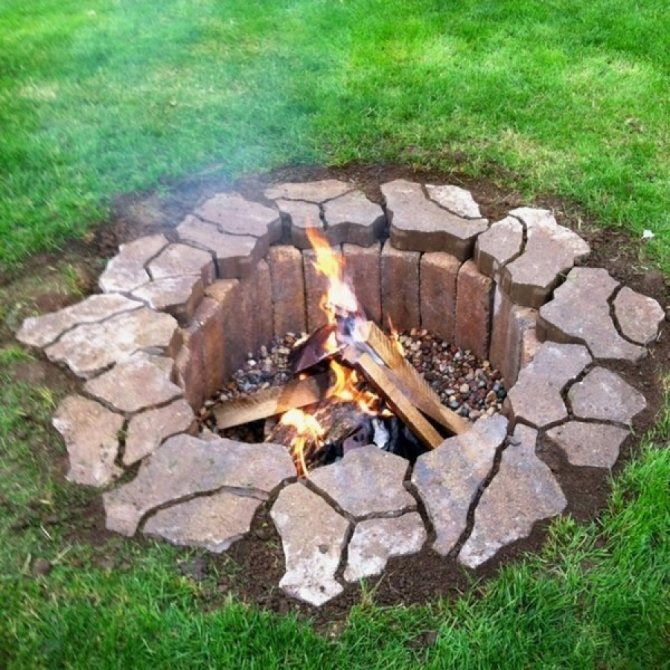

Method three. We use an old heater for waste disposal
If you have an old sauna stove lying around, then do not rush to send it to the landfill. Even if it is badly rotten or rusted. A stove, which has long become unusable, we can turn into a fairly good waste disposal unit by installing it in our summer cottage. We do it as follows. First, using the tools at hand, we remove all internal elements from the heater - we only leave the grate and, of course, the body itself.
After that, we take sheet steel and weld it to the base from the inside, thus strengthening the entire structure.
In this case, we will be able to load garbage directly from above, although before loading large elements, it is recommended to ignite the flame in advance with the help of dry branches and paper. Directly during the combustion process, it is advisable to cover the furnace with an iron sheet, placing pieces of brick under it - this will ensure the unhindered exit of flue gases.
Using an old heater
The dismantled old metal stove from the bath should not be thrown away. It can still do a good job as a waste incinerator. For such an application, it is worth removing all internal parts from the stove, because only the body and the grate are required. Inside, the base should be covered with steel sheets, welded to the body. Garbage is loaded into such a structure from above. If you plan to incinerate a large amount of waste or large elements, you should first make a fire and only then proceed with the procedure for cleaning the site. A garbage incinerator for a summer cottage, assembled from an old heater, is capable of "utilizing" large volumes, and it is not difficult to work with it. During combustion, it is recommended to close its top with a steel damper. This is a kind of miniature waste incineration plant.
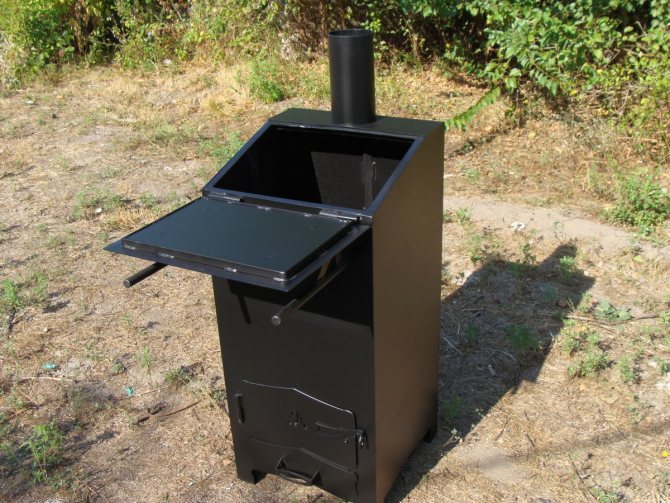

Method four. Waste disposal brick stove
Let's make a reservation right away that a capital structure made of bricks will last an order of magnitude longer than the metal waste disposers described above. And yes, and its aesthetic indicators are at a fairly high level, because such a stove will be an excellent decoration for any suburban area.With an average volume of garbage, a smaller and smaller structure will be required (only 115 bricks are needed), although if necessary, we can increase its dimensions. The procedure in this case is shown below.
Step one. First, we clear an area with dimensions of 1x0.7 meters, after which we fill it with sand (the layer thickness should be at least 5 centimeters).
Step two. We lay the first layer of bricks around the perimeter of the future structure. We do not use the solution for this, but put it "dry". It is important that there is a slight gap between the bricks (at least 1.5 centimeters) in order to ensure good traction. In total, the first layer will require eight bricks: one on the right and on the left, three each at the top and bottom.
Step three. After that, we lay down a metal grate (you can use reinforcing rods instead), which we welded in advance from a thick wire. If we talk about our specific design with its dimensions, then it needs a lattice of 3 transverse rods and 14 longitudinal ones. At the same stage, you need to take care of the ash pan. There are several options here:
- lay out a brick ash pan;
- pour it out of concrete;
- made of sheet steel.
Which option will be chosen does not play a special role, so we will not dwell on this issue.
Step four. We continue to build a garbage oven at the dacha with our own hands. For the next row, we also need eight bricks, but here we are already observing the dressing, so we already lay two units on the sides. In a similar way, we lay all subsequent rows, and we do not use the solution, as at first. We carry out the last, twelfth row in a continuous one. We install an iron cover on top of it.
Video - Burning garbage correctly
Safety regulations
Incineration of waste is hardly a safe pastime, as there may be trees, bushes or wooden buildings on the site. If there is a strong wind, the sparks can scatter and cause a fire. In a word, when burning garbage, it is imperative to adhere to safety requirements.
Regardless of how high-quality your oven is, always be there when it is working. Do not burn garbage if it is hot or windy outside. Place a container filled with sand or water next to the stove.
If you follow all these requirements, you can get rid of the accumulated garbage as safely as possible for yourself and those around you.
As a conclusion. Factory stoves
If you do not want to make a garbage oven for your summer cottage with your own hands, then you can purchase a ready-made version. Such structures will differ in that, in addition to the elements known to us, they are also equipped with a box for collecting ash.
They can be rectangular and round in shape. For the manufacture of the case, durable steel is used, it is also covered with refractory enamel. But we are talking about simple containers, and there are also more complex designs on sale. So, for example, you can buy one of the multifunctional models with which you can also heat water.
Finally, install and use such equipment only in accordance with safety regulations!
v-teplo.ru
When another waste incinerator burned out, I decided to do something more durable. At first there was an idea to weld a metal stove, but then I decided to use the bricks that remained after laying the fireplace. I decided to make the lining of an ordinary thin-walled metal barrel with bricks. So let's start with the foundation. He marked the pit 75x75 cm. I chose soil on the bayonet of the shovel and covered the pit with gravel. Made the formwork. Then I covered everything with old polyethylene and cast a slab of concrete. I reinforced everything with the remnants of a masonry mesh. While the concrete hardened, it turned to bricks.Each brick was turned to give a trapezoidal shape. I still have a few fireclay bricks and red oven bricks. I decided to make the lowest row of fireclay, and two upper ones from red. I used an iron barrel lid as a template. We start laying the stove. First, lay out the row without mortar. I used chamotte clay as a solution. It took only half a bag. I added a little sand, as did the stove-makers who put me a fireplace and a sauna stove. The first row is laid. It turned out that he was mistaken with the size of the furnace door. We spread the second row. And then the third last row. The grate decided to weld from a metal bar and reinforcement 10 mm. To be continued.
www.forumhouse.ru
What does the drum incineration law say?
Traditionally, garden waste generated in the country is burned. Some summer residents make a fire in their area or next to it, others equip a furnace for burning garbage or use an iron barrel for this purpose. From the latter, you can make the simplest garden oven with your own hands.
Before taking the listed actions, tributaries should study the law and make sure that their activities do not contradict it.
Important: According to article 20.4 of the Code of Administrative Offenses of the Russian Federation, both in cities and in rural areas it is prohibited to burn garbage.
There are several reasons why the state and its pressured environmental services are pushing laws to ban burning waste in stoves, barrels and open fires. It:
- the huge number of annual fires caused by the actions of citizens;
- burning of dried vegetation negatively affects nature, hazardous combustion products are released into the atmosphere.
Smoke-poisoned air interferes with the normal breathing of people suffering from asthma, hypertension and other diseases.
In order to prevent citizens from violating legal norms, fire inspectors and representatives of environmental organizations organize verification raids in order to identify violations.
In raids, technical means are used - drones with cameras that allow you to quickly identify areas of fire.
At first, briefings are given to violators. If citizens continue to act contrary to the law, they are subject to sanctions.
Responsibility for violation of the law


Another law that introduces a ban on waste incineration is the Federal Law "On the Protection of Atmospheric Air". Legislation clearly states that garbage cannot be burned:
- in containers;
- in urns;
- in barrels;
- in open spaces.
What is the essence of the problem
In any season, a lot of garbage is generated in the country. In summer - construction and food waste, tops of various vegetables, in autumn - leaves and branches after pruning, in spring - the "results" of general cleaning of the site. Perhaps only in winter there is a slight lull, and mainly food waste is flying into the trash can.
Important: The law of the Moscow region (a similar situation in other regions) of November 29, 2005 N 249/2005-OZ prohibited from burning trash, foliage and grass even on your own site! You should not get carried away with this process, especially without a closed oven and in front of unfriendly neighbors, since they only need to call the district police officer, the fire service, or simply fix the smoke on the camera and take the evidence to the appropriate authorities.
There is no ideal way to "work" with waste. Everyone chooses what is convenient for him. But, I think, no one seeks to litter the surrounding forests and arrange ugly spontaneous dumps near the villages. Therefore, many gardeners burn garbage. After all, you can burn everything, from dry twigs to plastic bottles and films from the greenhouse (it is still better to throw them in the trash, since burning plastic does not emit anything useful) - and you do not need to carry it far.
And now, when the essence of the problem is clear, let's try to figure out what is the best way to burn garbage and what safety precautions must be followed so as not to harm ourselves, neighbors, or the environment.
Types of incinerators
You've probably seen how an old refrigerator, barrel, stove or bucket is used as an incinerator. Some craftsmen even build a homemade hearth. What's better? There is no definite answer. Therefore, I will give several ways. For them, various devices are used: from homemade to store.
Iron barrel
Perhaps the most popular option. At any cottage there is an iron barrel into which water is collected for irrigation. Over time, the container ages, rusts, becomes leaky and cannot perform its main function.
Such a barrel can be put under the hearth for incineration.
Such a not quite dilapidated barrel can be made a hearth for burning garbage. It has both pros and cons.
Pros:
- Mobility (everyone can move the barrel to the right place on the site);
- Lack of open fire (compared to a conventional fire);
- Fire control (if necessary, it can be extinguished immediately).
Minuses:
- From constant exposure to high temperatures, the barrel will gradually become unusable, and it will have to be replaced;
- If not properly positioned and used, it can be as dangerous as an open fire.
How to turn a barrel into an oven?
It all depends on whether it is with a bottom or without. A barrel without a bottom is placed on the ground, and a barrel with a bottom is placed on bricks. Now in more detail.
a) We turn a barrel without a bottom into an oven:
- We remove the bottom. The old "residents" of the country shed do not have it anyway. Or it’s so rotten that there’s no problem. If the barrel is new, then you will have to work with a grinder.
- We make holes at the bottom. They are needed for traction. They can be easily done with a drill or chisel.
- Digging a hole. For fire safety, which will be discussed separately a little later, the barrel must be placed in a pit. Its length is about 1 m, and its width and depth are one shovel bayonet (about 30-40 cm).
- We make a fire in the pit. Naturally, at this stage it should be small.
- Installing the barrel.
- We put garbage in portions.
- Thanks to good traction, boards, branches and other waste will burn easily, leaving you with a bunch of useful ash.
Thanks to the good air draft coming from the holes, boards, branches, etc. will burn easily
b) We turn a barrel with a bottom into an oven
With this option, on the one hand, everything is a little easier (no need to knock out the bottom and dig a hole), and on the other hand, it is more difficult (to build a brick base, drill holes in the bottom, etc.). So:
- We drill or punch holes in the bottom of the barrel.
- Create a thrust at the bottom of the barrel (same as in the case of the "bottomless").
- We build a brick base. Be sure to take into account the required distance for air intake.
- We put the barrel on the bricks.
- We light the fire and put the trash
By the way, if you do not like the dull monochromatic color of the barrel, you can change it to a more fun one with the help of heat-resistant paints and imagination. Then the barrel will not only do its job, but also please the eye.
Incinerator
A major incinerator is another decent option.
Incinerator
Of course, it is less popular because it takes longer to build. And a branded oven from a store is more expensive.
Homemade incinerator
Most gardeners adapt a sauna stove for waste disposal. In second place is the old stove-potbelly stove (in which you can't burn much, but for pieces of paper, newspapers, wood chips and other trifles - that's it). In third place is the 115 bricks oven.
It is not for nothing that a brick oven is called 115 bricks, because that is how much you need to build it.
Let us dwell in more detail on the stove and the brick stove, since everything is clear with the potbelly stove. It is enough to transfer it to the right place, and you can start burning. But sauna stove - a very interesting specimen. If it is no longer useful in the bath, do not rush to turn it into trash. It is not so difficult to convert it and turn it into a utilizer:
- We remove the internal parts, as a result, only the body and the grill remain.
- We make the body more durable by welding sheet metal to it from the inside.
- We make a fire, load garbage from above and cover the structure with a sheet of metal so that there is no open flame. Air draft will be provided by a stone placed under this sheet.
Brick oven no wonder they call "115 bricks", because that is how many pieces you need to build it. This is a standard, one might say, classic size, but if desired, it can be increased. It is very difficult to describe how "115 bricks" is created in one article, since no one can explain the laying process better than a professional or someone who has ever laid a stove with his own hands. One thing I can say for sure: this is a time-consuming process, but the result is worth it. Neat brick beauties-stoves will not spoil the appearance of the site. And an ignorant person may not even guess about their true purpose.
Signature incinerators
Sometimes they are also called waste incinerators. Branded incinerator. Photo from catalog2b.ru
Stove manufacturers unanimously claim that such stoves are convenient, functional and aesthetic. This is confirmed by summer residents. If we compare ready-made ovens with barrels or homemade options, then the advantages of the former are obvious. There is no need to tinker and invent anything: you buy, install and use. Some manage to not only burn garbage in them, but also heat water or cook dinner if the stove is equipped with a stove on top, and wood is burned inside, not polyethylene.
A conventional incinerator has two "floors": a combustion chamber and an ash pan. The improved kit will also have a chimney or the above-mentioned stove. In terms of appearance, there are round, square or barrel-like ovens - with or without a handle and wheels. The body is made of steel, coated with fire-resistant enamel. The volume varies: there are smaller or larger ovens, for 160 liters. Prices also vary: from 6 to 15 thousand rubles.
The design of any furnace isolates waste, protects against sparks and allows ash to be collected without problems.
How to make a waste incinerator
There are no exact instructions and models of such barrels, it all depends on your capabilities and imagination. The main material is a metal barrel, and it can already be improved at will.
Most often, one of two simple designs is used, which differ only slightly:
- A barrel without a bottom, mounted on bricks. Leaky structures can still serve. Choose a flat place, cover with sand and put a metal sheet on it so that the heat is not on the ground. Install a support from bricks, laying them out with the letter P, and put a grate so that debris does not fall out. It remains to place the barrel on the bricks and the oven is ready. It is convenient to light it up from the bottom on the side where there are no bricks, and to lay it on top.


- Stove in a barrel with a bottom. Instead of a brick support, make legs and weld them. In the barrel itself, drill holes in the bottom to improve traction. And for laying waste, weld the grate inside about 15 -20 cm from the bottom. To complete the image of the stove, a blower cut out just above the wheels. Put it on the hinges and then it will be possible to regulate the strength of the fire.


To prevent moisture from getting inside the "garbage oven" during rains, cover it with a sheet of metal on top.
Some safety tips
- Garbage should be burned as far as possible from buildings, dry vegetation and combustible materials.
- Do not leave the hearth unattended.
- Do not get carried away with burning plastic and polyethylene: combustion products give off toxic substances.
- Do not burn garbage in dry, hot or windy weather.
- There should be a "kit" for extinguishing a fire - sand and water - near the hearth.
- Do not place the hearth on dry grass, boards or other flammable materials.
- The access of animals and small children to the hearth should be limited.
Burning should be carried out as far as possible from buildings, dry vegetation and combustible materials
The basic incinerators that are used by the majority, we have considered. But maybe you have some unusual solutions of your own that you want to share with your readers?
7dach.ru
Safety Tips
- The waste incineration process must be supervised;
- There should be a box of sand or a container with water near such a furnace, so that in an emergency situation you can quickly extinguish the flame;
- If there are children in the country, it is necessary to block their access to the stove.
Accordingly, buying a ready-made oven or making it yourself is everyone's personal choice. And in those, and in others there are advantages and disadvantages that must be considered.
kladempech.ru
Why make a waste incinerator?
Incineration is the most efficient way to dispose of plant waste for owners of private houses and land.
Note! According to the law, natural waste cannot be thrown into containers for general use intended for solid domestic waste (solid household waste), but must be stored in a compost pit or box on the site. But over time, as it grows, the compost heap can take up too much space.
There are several ways to burn unnecessary things:
- at the stake;
- in a suitable metal container, such as a garden barrel;
- in a special oven.
Of course, the least environmentally friendly and safest way is to make open fires. After all, gusts of wind can spread sparks and a burning mass to the sides, which can cause a fire. In addition, the scorched and burnt earth under the ashes becomes "dead" for a long time.
From this point of view, putting garbage for incineration in an iron container is the safest, but it also has a number of disadvantages:
- used containers with sufficiently thin walls quickly burn out and become unusable;
- due to the lack of traction, the compressed mass of waste remains untouched by the fire at the bottom;
- flying sparks and burning pieces can also cause a fire.
So, with the burning of garbage, the owner of the house is trapped by various dirty tricks.
Important! In order to comply with fire safety, Russian legislation prohibits burning waste both in the city and in the country, and on a suburban area (in an open area or in a barrel, trash can, container). Violators face a fine from 2,000 (for individuals) to 200,000 rubles (for legal entities).
An acceptable solution is the incineration of waste in a special furnace, made in accordance with all fire safety requirements. Also in the country you can burn garbage in a barrel.
How to make a garbage incinerator in the country with your own hands
Adding an article to a new collection
Dry leaves, potato tops, cut branches of shrubs - all this has to be burned in the country to stop the spread of diseases and pests. But the fines for fires are substantial, and you don't want to run the risk of a fire. The plant waste incinerator will solve the problem!
Summer residents have long been using old metal barrels for burning plant residues, but the trouble is that barrels burn out quickly and become unusable in a couple of seasons. An excellent technological solution was found by Leonid Kotlyar, who designed and manufactured his own incinerator for his summer cottage.
Vegetable and food waste at dachas is disposed of in different ways, gardeners compost part of the waste, receiving high-quality organic fertilizer, but this technique is not suitable for tops of tomatoes, potatoes and thorny gooseberry branches.
Most of such waste accumulates during harvesting, there is simply nowhere to store them until dry, and in raw form they do not burn. It also happens - the raw tops are thrown into the fire, it goes out, smoldering begins, the observation of the fire stops, the owners leave in the evening, and the fire is blown by the night wind and passes to wooden buildings.
Another way of getting rid of plant waste is gaining strength, when they are thrown into the garbage collection container of all SNT. In our horticultural partnership last year 2.3 million rubles were paid for garbage collection, or 12% of the collected fees, and there is an annual growth of 100 thousand rubles.
Well, now let's move on from the introduction to the point. The problem of incineration of summer cottage waste was before me for a long time. And when, after the repair, the bricks, the firebox door assembly and the old steel pipes of water heating remained unclaimed, I decided to experiment a little. Apart from the above, I did not know what to do with the steel barrel. For many years a fire was lit in it, where plant waste was burned, and so intensely that the bottom fell off, and a third of the height of the barrel burned out in places.
These were the initial prerequisites for the development of a green plant waste incinerator.
Such a development does not require great intelligence - the stove, like any other, has a foundation, an ash pan (blower), a firebox, but instead of a stove with cast-iron burners (rings), a second grate is installed (a copy of the first), and the pipe stands directly on the grate - the remainder of former barrels, where plant waste is placed. The main requirement for the design of the furnace is the coincidence of the diameter of the barrel with the square of the side of the brickwork.
What are the types of incinerators. Advantages and disadvantages
Typical waste incinerators are usually made of steel. Additionally, the metal is covered with a special enamel that is resistant to high temperatures.
Usually stationary structures are more spacious, but a more mobile portable version can also be purchased.
Stationary models are usually more bulky and heavy, but they can dispose of a large volume at a time or burn large debris (long branches, boards, etc.).
If you need to burn a large amount of waste, you will have to load the portable stove many times and grind large pieces, but it will easily fit in the trunk of your car and can be easily carried from place to place by one person.
At the bottom of the furnace there is a special grate - a grate, which simultaneously allows air to enter, holds the burning mass and subsequently ensures the loss of burnt ash.
In addition to these points, it is worth paying attention to the following parameters:
- The thickness of the metal must be at least 2 mm. The thicker the steel used, the longer the service life of the unit will be. Thin metal will burn out quickly enough.
- The most convenient structures to use are those that provide for special holes and doors for cleaning ash.
- The garden waste incinerator must be completely fireproof. The penetration of sparks, fire or the fallout of coals into the air is absolutely unacceptable.
- The top cover not only limits the release of fire, but also protects the contents from possible precipitation.
- In models with a chimney, combustion is faster due to increased draft.
Today, more complex designs can also be purchased, for example, a model combining a waste incinerator and a heating boiler for domestic needs. This oven is additionally equipped with a water heater and a water pump. The undoubted advantage of this model is that it is "water purification" of harmful combustion products, that is, it is more environmentally friendly.
Types of incinerators
A waste incinerator is usually made of steel sheets and is additionally coated with a special enamel that is resistant to high temperatures. Distinguish between stationary and mobile structures.
Stationary
This option is more spacious and therefore convenient. Stationary models are made only in large sizes, since there is no need to move them. The stoves are very heavy, but dispose of in them will result in a large amount of collected waste.
For disposal, you can put various boards, long branches or any other rubbish.
Mobile portable
If you do not regularly need to incinerate large amounts of waste on site, then portable equipment is ideal. The stove is compact and does not take up much space. But the small size also causes certain difficulties. It will take many times to load the accumulated garbage into it, and also grind large pieces.
But if it is necessary to move the stove from the house to the dacha, then it will easily fit into the trunk of a car. The unit is light enough to be carried by one person without assistance.
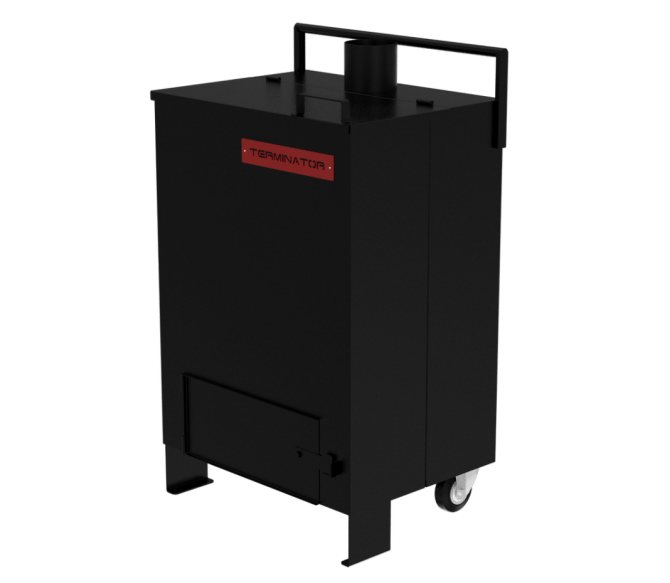

Portable incinerator
There are a large number of designs on the market, which also differ in increased complexity compared to previous models. For example, there are ovens that combine a boiler and an incinerator. In such a unit, a water heater and a special pump are usually installed, with the help of which water under pressure will be supplied. The plus of the model is the mode of water cleaning from combustion products. Thus, the device is more environmentally friendly.
We make a country stove for burning garbage with our own hands
The simplest and therefore the most common ways to build a garbage oven with your own hands is to use a garden metal barrel for its manufacture or lay it out of bricks.
Garden barrel oven
The procedure for manufacturing such a device for incinerating summer cottage waste is quite simple for any craftsman:
- A door is cut out at the end of the barrel. To do this, first, a neat straight cut of the bottom of the barrel is made with a grinder. It is important not to touch the edges. To cut the lid further, a hole is made from which the lid is carefully cut out with a jigsaw. Next, in the door, we drill the holes necessary for air to enter.
- If you are using an old barrel, then it must be cleaned of rust and old paint.
- We build trestles to accommodate the future stove. For this, you can use, for example, a metal profile. Before fastening the parts, they must first be painted with refractory paint.
- We also paint the barrel. We are waiting for all the components of the future structure to dry to the end.
- We attach the door to the hinges. We mount the handle.
- In the upper part of the structure we make a hole for the chimney. We install a chimney - a tin pipe about one and a half meters long.
- It remains to place the grate at the bottom of the unit.
And the convenient and fireproof waste incinerator is ready!
Additional information on the manufacture of a vertical design stove from a garden barrel in the video materials: instructions, principle of operation, possibilities of use.
Brick Waste Incinerator
A masonry stove for disposal of waste is also not difficult to design. First you need to choose a permanent place to place it on the site. You will need a piece of land about 70 by 100 centimeters in size. To make a base for a future structure out of it, it is covered with a 5-7 cm layer of sand and laid out with bricks.
Then follow the next steps:
- The first row of bricks is laid without mortar. To create traction, small gaps (about one and a half centimeters) are left between the stones. One brick is missing - this is the door through which you will rake ash in the future.
- Steel grate - the grate is placed on the first row of bricks. For its manufacture, for example, welded reinforcement rods are suitable.
- The next glad - even - fits "with a dressing" (in a checkerboard pattern).
- Thus, alternating even and odd rows, the "heater" can be made 10-12 brick rows high.
- For safety, the structure is closed from above with a metal cover.
"Craftsmen" also often adapt large iron flasks for the manufacture of country stoves: they are already equipped with convenient lids, it remains to mount the chimney, drill holes for draft and install the grate.
It can be easily converted into a stove and an old sauna heater. For "transformation" all unnecessary details are removed from it, leaving only the body and grate.
The main thing to remember when making or buying your stove is that in the first place it is you who can suffer from any non-compliance with fire protection techniques. It must be made as reliably as possible, "conscientiously". Then cleaning your site from plant waste will be easy and not burdensome for you, and most importantly - absolutely safe.
vtorothody.ru
Typical waste incinerators
They are made of steel with a thickness of 2 mm, covered with refractory enamel. Small dimensions, which makes it easy to transport the stove in a passenger car. The combustion process takes place on the grate grate, which retains large debris and household waste, and also does not impede the flow of air from the lower part of the furnace.
Ash itself falls through the bars of the grate. Combustion is regulated by opening / closing the blower door through which oxygen is supplied. From there, ash is scooped up, which gardeners love to use as fertilizer for the site. There is a cover on top that not only protects the flame from rain, but also serves as a limiter.
Stove boiler
Such stoves, in addition to burning waste at the site, are also used as a heating boiler. The stove is equipped with a water heater, as well as a vapor-vacuum pump, which serves to supply water directly to the house.
The smoke is cleaned in the furnace, which allows us to call it environmentally friendly, since the combustion products are bound by water in the chimney. A stove filled with saw cut, unnecessary rags and other waste is enough to heat the house for 24 hours. A special boiler stove will help clean the area and reduce fuel costs.
Waste stoves and incinerators
Each garden plot requires periodic cleaning of fallen leaves, dry branches, weeds and other wood debris.
In a suburban area, the question of garbage disposal often arises. Waste disposal is quite expensive, so most owners of such real estate prefer the traditional way of disposing of trash - incineration. It is unsafe to make fires in an open area; it will be more efficient to burn waste in an incinerator or garden oven. This design can also be purchased in our store.
You can also purchase a waste incinerator in the country in a ready-made form. If you do not want to clutter up the site with unsightly barrels or engage in brickwork, then such devices will be the best solution for you. They consist of a combustion chamber, a box for the accumulation of ash, and a firebox with a grate. Recycling ovens can be of different shapes: square; round; rectangular. Outwardly, they resemble airtight containers. The body is usually made of durable steel, which is coated with a fire-resistant enamel. An incinerator from the manufacturer may have additional functions, for example, the ability to heat water. When choosing such a device, you should pay attention to the volume of the combustion chamber. This parameter should be related to the amount of accumulated waste. The safest and most effective models are considered to be with a chimney, since the chimney will remove smoke and intensify combustion.
Safety regulations.
The waste incinerator must be used in accordance with safety regulations. Install the incinerator and dispose of waste away from vegetation and houses. Kindling is prohibited during extreme heat or wind. Do not install the stove on dry grass, as it can catch fire and spread the fire throughout the area. Access to the incinerator must be limited if there are animals or small children in the country. When burning garbage, it is recommended to stay near the stove, not leaving it unattended.
Mob.
NADA
• Russia, Moscow, st. Yartsevskaya, 34, building 1 Working hours: Monday - Sunday from 10:00 to 19:00 Delivery from 9-00 to 18-00
